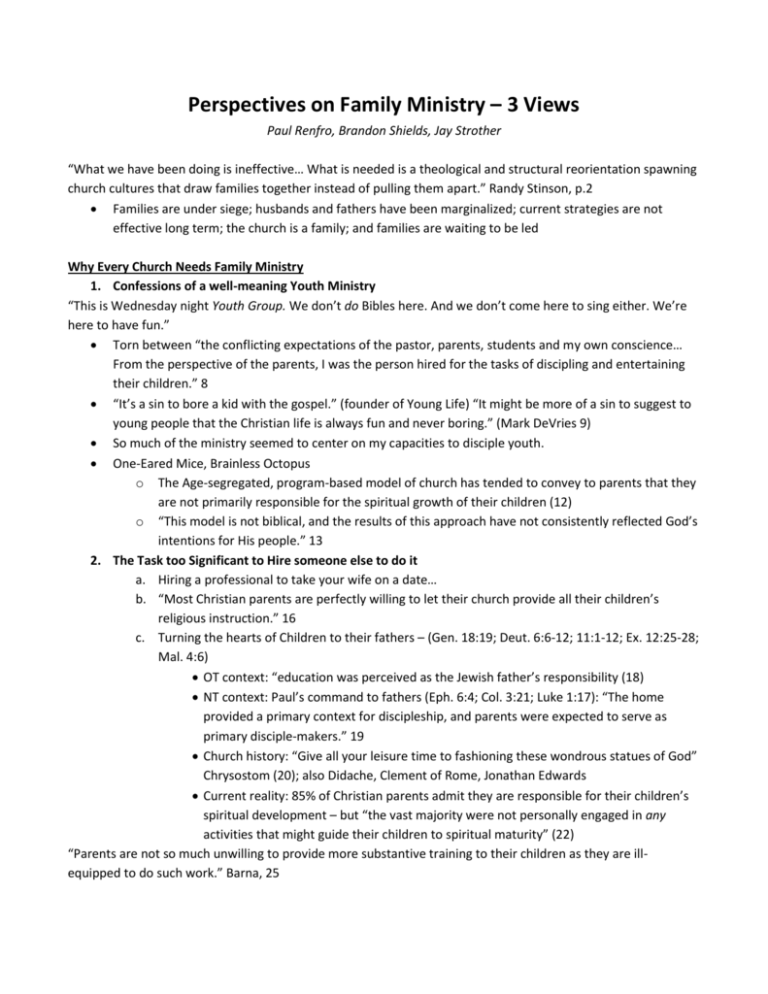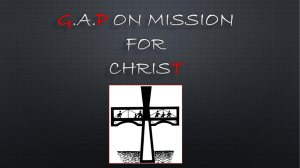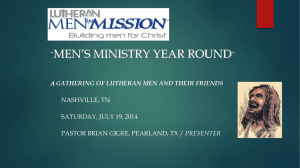Perspectives on Family Ministry
advertisement

Perspectives on Family Ministry – 3 Views Paul Renfro, Brandon Shields, Jay Strother “What we have been doing is ineffective… What is needed is a theological and structural reorientation spawning church cultures that draw families together instead of pulling them apart.” Randy Stinson, p.2 Families are under siege; husbands and fathers have been marginalized; current strategies are not effective long term; the church is a family; and families are waiting to be led Why Every Church Needs Family Ministry 1. Confessions of a well-meaning Youth Ministry “This is Wednesday night Youth Group. We don’t do Bibles here. And we don’t come here to sing either. We’re here to have fun.” Torn between “the conflicting expectations of the pastor, parents, students and my own conscience… From the perspective of the parents, I was the person hired for the tasks of discipling and entertaining their children.” 8 “It’s a sin to bore a kid with the gospel.” (founder of Young Life) “It might be more of a sin to suggest to young people that the Christian life is always fun and never boring.” (Mark DeVries 9) So much of the ministry seemed to center on my capacities to disciple youth. One-Eared Mice, Brainless Octopus o The Age-segregated, program-based model of church has tended to convey to parents that they are not primarily responsible for the spiritual growth of their children (12) o “This model is not biblical, and the results of this approach have not consistently reflected God’s intentions for His people.” 13 2. The Task too Significant to Hire someone else to do it a. Hiring a professional to take your wife on a date… b. “Most Christian parents are perfectly willing to let their church provide all their children’s religious instruction.” 16 c. Turning the hearts of Children to their fathers – (Gen. 18:19; Deut. 6:6-12; 11:1-12; Ex. 12:25-28; Mal. 4:6) OT context: “education was perceived as the Jewish father’s responsibility (18) NT context: Paul’s command to fathers (Eph. 6:4; Col. 3:21; Luke 1:17): “The home provided a primary context for discipleship, and parents were expected to serve as primary disciple-makers.” 19 Church history: “Give all your leisure time to fashioning these wondrous statues of God” Chrysostom (20); also Didache, Clement of Rome, Jonathan Edwards Current reality: 85% of Christian parents admit they are responsible for their children’s spiritual development – but “the vast majority were not personally engaged in any activities that might guide their children to spiritual maturity” (22) “Parents are not so much unwilling to provide more substantive training to their children as they are illequipped to do such work.” Barna, 25 3. Historical Contexts for Family Ministry “Youth… have bad manners, contempt for authority; they… love chatter in place of exercise” Socrates,26 a. The Invention of Adolescence: “The teenage years shifted from an intermediary life-stage with the goal of adulthood to a distinct social and cultural structure that resisted movement toward adulthood.” 27 Pre-Industrial Revolution: all-aged children worked in their homes w/ family 1848 – Horace Mann – “Education… is the great equalizer… of men” 29 1875 – Supreme Court sanctions tax dollars for free High Schools for all Young Peoples Societies emerge in response to increase in HS attendance 1904 – G. Stanley Hall – map of human development: “period of storm and stress when old moorings were broken” – allow adolescents to wander far and long “to find the best habitat.” 30 Great Depression – new truancy laws to keep teens from taking jobs Increasing Secularization – John Dewey’s “common faith” = without God 1940s-50s – new American, post-war ideal: youth exempted from working to support the family, given spending money, then targeted by marketing! “It was adults, especially fathers, who gradually disappeared from children’s spheres of existence, throwing themselves into their own pursuits of leisure and labor.” 32 “By the end of the 20th C., the typical American parent spent fewer than fifteen minutes each week in significant dialogue with his or her child.” 32 1950s - Parachurch ministries arose in response to the needs of this new generation – YFC, Young Life… ‘60s-‘70s - Churches copied parachurch models, but then shifted from trying to reach non-believing teens to trying to keep believing teens Late ‘90s “the church is realizing that maybe it’s time to start putting the family back together again.” 35 4. Foundations for Family Ministry a. Approaches to Family Ministry: Therapeutic Counseling – church-based courses and seminars to strengthen intact families and offer crisis counseling for troubled families Church-as-Family – the church’s effort to connect everyone in family-like relationships (with no real emphasis on parents) Nuclear-Family – “the primary training ground for discipleship and spiritual formation is the nuclear family rather than the local church.” 39 b. Definition: “the process of intentionally and persistently realigning a congregation’s proclamation and practices so that parents are acknowledged, trained, and held accountable as the persons primarily responsible for the discipleship of their children.” 40 Not merely one more method or program to add on – but a “fundamentally different way of doing church.” 41 c. Models for Family Ministry: Family Integrated – 1. All age-graded classes and events are eliminated 2. Generations worship and learn together 3. Parents bear primary responsibility for evangelism and discipleship of their children (and families do outreach together as well) Family-Based – 1. No radical changes in the church’s programmatic structures 2. Each ministry sponsors events and experiences designed to draw generations together and help parents train their own children 3. Sunflower – each age-graded petal is independent, but united around the central hub of supporting families Family-Equipping – 1. Many age-graded ministries remain 2. Every ministry champions the place of parents as primary disciple-makers 3. “The church equips parents to disciple their children, and the parents recognize the church as an active partner in this process.” 44 4. River with large stones – one bank is the church, the other is the family, both support a child’s growth; stones are milestones that mark key developmental stages that church and family celebrate together d. Relating the Models Together: Programmatic (age-graded) – Family-based – Family-Equipping – Family-Integrated (See chart on p. 52 comparing the four approaches) Some overlap between each in the continuum. e. Common Ground Scripture as supreme and sufficient standard Parents are primarily responsible for Christian formation of their children The generations need one another “Churches somehow expect family members to become integrated with one another at home even as they model disintegration in their activities and organizational structures.” 49 How Churches are Doing Family Ministry 5. Family-Integrated Ministry: Family-Driven Faith a. Intro – many youth pastors spend 90% of their time on administrative tasks, “oiling the organizational machinery,” not investing in people’s lives b. Definition: “The biblical family is a scripturally-ordered household of parents, children, and sometimes others… forming the God-ordained building blocks of the church (2 Tim. 4:19). We… reject the church’s implementation of modern individualism by fragmenting the family through age-graded, peer-oriented, and special-interest classes, thus preventing rather than promoting family unity.” 55 c. Description: no youth ministry, children’s programs or nursery – no separation of families; simple leadership team of elders; deacons oversee operations; a weekly worship celebration followed by a potluck meal and small groups during the week; monthly men’s meeting to train men as spiritual leaders. Worship – show kids that worship is broader than their peers; work through a prayer guide; include catechism questions; expository preaching; Lord’s supper; fellowship meal Training Members – small groups include kids of all ages along with adults; Training Fathers to lead – monthly meeting for worship, testimonies, family discipleship Q&A, encouragement and prayer The Myth of Adolescence – “In contemporary culture, acceptance of an extended immaturity, especially for males, has replaced the ancient expectation of moving toward adult responsibilities.” 60 12th birthday celebration of manhood! d. Distinctives Evangelism and Discipleship thru the Home – parents are primary (Eph. 6:1-4); “the home is the best context for discipleship, and the family is also the best context for evangelism” 63 focus on fathers! Biblical Leadership – only qualified elders, who “manage their families well” e. Dangers Today “Religious congregations are losing out to school and the media for the time and attention of youth…” 66 “There is very little built-in religious content or connection in the structure of most U.S. adolescents’ daily schedules and routines.” 67 “Schools, media, and peers are the ‘disciplers’ of America’s children – discipling them in secular humanism and vague, self-centered spirituality.” 67 f. History Fathers trained their children – Abraham (Gen. 18:19); Deut. 6; Ps. 78; Eph. 6:4; Col. 3:23 Age Integration was normative – no age segregation (Deut. 31:12; Ez. 10:1; Eph. 6:1-3; Col. 3:20) Families worshiped together – the altar (Gen. 8:16-20; 22); family worship thru 18th and 19th C. g. FAQs Neglect children’s spiritual training? “What better context than the home, where the events of each day are rich with opportunities for teaching, correcting, and applying biblical truth?” 71 Isolated, insulated? Not reclusive “house churches” where a few families stay together for years – these lack the leadership, structure, discipline and mission of a NT congregation Singles? The church is distinct from the family – both work together to bless each other and expand the kingdom. Single moms engage with married moms, they are not all clustered together Evangelistic? The home’s hospitality is a powerful witness Home-schoolers only? “Most of our families educate their children at home. This is probably because home educators and family integrators share many of the same values.” 76 Transitioning to this model? This is a huge paradigm shift… “In some cases a young person is so tightly connected to a youth group that he or she is more committed to that youth group than their own family.” 74 1. Training husbands and wives in their God-ordained roles – esp men! 2. Training children – to sit and pay attention. “Does this structure reflect the ideal structure of NT churches? Does the church’s leadership meet the qualifications that are spelled out in the Bible? … Are men leading families? Are parents discipling their children? Are wives helping and submitting to their husbands? Are children obeying the fifth commandment? Are there ministries of intergenerational discipleship…? Do we practice hospitality toward one another and toward the world? Are we engaging in biblical evangelism? A church is successful only to the degree that it lines up with Scripture in these areas.” 77 “Integration returns time to families, so that families can be families – living, learning, working, ministering, worshiping, and playing together.” 78 6. Responses a. Shields: The church is not primarily a “family of families” – but the family of God; allegiance to Jesus replaces other family ties; “the nuclear family is not God’s primary mechanism for accomplishing the Great Commission… rather, the local church clearly bears this responsibility.” 81 Public-School Families are not adequately reached – homeschooling families represent less than 2% of today’s kids; almost 50 million public school kids = the largest mission field in America! Every church segregates – even Family Integrated sometimes segregate older men; or have women and girls prepare meals… b. Strother: How would you transition to this? Is there room for incremental shifts? How do you reach nontraditional families? How do you equip children and youth to engage contemporary culture with their faith? 1. Adolescence may be recent, but it is “a cultural reality.” How can we reach students who live in this reality? 2. Are age-graded programs really the problem? “Can the investment of one or two hours each week in Bible study with a supportive peer group, led by a spiritually mature adult, truly cause parents to ‘lose their child’s heart’?” 88 3. Family Integration may have swung the pendulum too far the other way c. Renfro’s Conclusion: “Family of families” refers to the structure of the church, not its nature. “God created the family as the primary training ground for children” 89 It’s not either/or, it’s both evangelism AND discipleship; “the church does not have to look like the culture to be effective.” 92 Age-graded youth ministry has not worked, change is in order! (91) Home-schooling – “We believe in speaking truth regarding the problems in present systems of public education… they are very real, resulting in widespread, systematic indoctrination of children in secular humanism.” (93) 94% of home-educated students retain the religious beliefs and practices of their parents. 7. Family-Based Ministry: Separated Contexts, Shared Focus “We are not suggesting a radical change in programming. What we are suggesting is a fresh mindset: Parents and family are crucial to faith development in every area of a ministry’s program.” 98 a. Refocus Age-graded ministries to partner intentionally with parents b. Age Segregation is not the problem The Dropout Statistic – 65-94% quit church in college (102) – these stats are “misleading and inconclusive”: some are merely anecdotes and “gut feelings,”; some include catholic and mainline stats; some include marginal participants… Shield’s study – 88% of those actively involved in “dynamic youth ministries” remained active as young adults; 93% of “engaged disciples” c. Age-Organized Ministry as Missiological Opportunity A vital tool to touch the hearts of lost students who otherwise might not have a chance to respond to the gospel (107) d. What Family-Based Ministry is NOT: Activity-Driven Ministry – drawing crowds and entertaining students at the expense of disciple-making Uni-generational Ministry – utilizing volunteers just a few years older than the target audience Culturally Immersed Ministry – “going native,” becoming indistinguishable from the culture you are trying to reach e. Family-Based Ministry is: Bible-based – despite accusations based on “regulative principle,”: “there is no clear biblical mandate for age-segregated ministry” (113); just contextualized ministry to accomplish Biblical goals Focused on Evangelism – aware of the historical and cultural realities, including problems of a breakdown in families, pursuing teens in the most effective ways Motivated by Compassion – for orphans and widows, reaching people in all family contexts, in every nation (28% of kids live with a single parent) 116 f. Maximum Kingdom Impact: Jason and Sarah’s positive experience thru their kids’ positive experience Richard and Terri’s over-churched preference for a more family integrated approach “Family based churches can reach out directly to youth and children to make Jesus known in the heart of the culture.” 120 8. Responses a. Renfro: Sola Cultura – What is the binding authority on the church? What determines how it thinks, what it wants, and how it is going to go about its business? Dangers of being overly driven by cultural “realities” Evangelism – “I reject the notion that intact families are somehow disadvantaged when it comes to sharing the message of Christ with shattered or struggling families.” 125 Training Parents? Age-segregation perpetuates “compartmentalization” of faith, keeping it out of the home… 126 b. Strother: “What are you doing to reach parents and reconnect them to their kids?” 127 “Most parents are perfectly content to sit back and allow the church to assume the role of primary spiritual caregiver in their children’s lives.” 129 Where do you draw the line when it comes to programs and events? Just add more and more activities? 130 “To equip parents properly… is going to require strategic movement through a specific series of intentionally planned steps that helps parents at every level of understanding.” 131 “Students become spiritually codependent on emotional moments that occur apart from the day-to-day disciplines of life… the deepest impressions on students’ lives occur in the far more mundane contexts, such as serving alongside parents in ministry of mission settings.” 132 c. Conclusion by Shields: Sola Scriptura: “Where the Scripture is silent… churches are free to pursue culturally appropriate methods for carrying out their mission…” 134 Evangelism – strategic focus on young people! “The work has been chiefly amongst the young; and comparatively few others have been partakers of it.” Jonathan Edwards (136), Spurgeon (137) Balance – training of families takes place in small groups, marriage retreats, leadership meetings, sermons, etc. The key is collaboration – where everyone works together to multiply the effectiveness of each person and group (138) 9. Family-Equipping Ministry: Church and home as Co-Champions a. Problems Today: Moral therapeutic deism (Smith, ’05) – “despite strong interest in religion and even active participation in vibrant churches, millions of students in our ministries were unable to articulate even the most basic tenets of Christian faith… religion is all about doing better and becoming happier.” 141 “The church had tacitly encouraged this parental abdication by relentlessly promoting benefits and life changes that would accompany increased participation in ministry activities.” 142 b. Principle: “The home has the greatest impact on young lives; with few exceptions, if we fail to impact the home, we will never make a lasting impact on students.” 143 Barna – “facilitate a parent-church partnership focused on instilling specific spiritual beliefs and practices in a child’s life from a very early age.” 143 “Family equipping churches retain some age-organized ministries but restructure the congregation to partner with parents at every level of ministry so that parents are acknowledged, equipped and held accountable for the discipleship of their children.” 144 c. Engaging and Equipping Parents A carefully planned partnership between church and family – co-champion of both Godordained institutions! “Most parents did have a purpose for their children’s lives, but this purpose was not maturity in Jesus Christ. Their purpose was for their children to be happy.” 147 Vision: “nothing less than raising them with the conviction that their primary goal is to leverage their lives to advance God’s kingdom so that every tribe, nation and people group have the opportunity to respond to their rightful king.” 148 d. Discipleship through Partnership Catalysts – Deut. 6:7 – 6 Biblical Characteristics: 1. Love God as a way of life (worship) 2. Love others as a way of life (service) 3. Love the church and understand their roles in the body of Christ (community) 4. Love the Bible and handle it properly as the authority and foundation for life (Scripture) 5. Love to tell others about Christ (the gospel) and share their stories (testimony) 6. Love to grow closer to God through personal spiritual disciplines such as prayer and Bible study (discipleship) 7 Ministry Strategies 1. Synchronize all ministry efforts around church-home partnership 2. Communicate expectations and plans to parents 3. Develop a resource guide for parents 4. Connect the church’s teaching ministry to the home 5. Provide catalytic venues to introduce parents to 6:7 expectations 6. Provide family-equipping mission opportunities 7. Develop family worship gatherings Content – build a scope and sequence, find or create resources to implement Context – be sure parents know your “playbook” “What these programs and events actually did was create more consumers of church programs and events.” 156 1. Every ministry context should: a. Ground family members in worship b. Grow them in discipleship c. And equip them to Go on mission e. History Family-equipping is an ancient theme – OT (Gen. 17:8-9; Ex. 12:3,21; 13:13-15; Deut. 6; Josh 4) “The family was the first and remains the best ‘small group’ anywhere!” 158 – Prov. 22:6; 1:8;4:1-4; 6:20) NT – Jesus was entrusted to other caring adults (Lk. 2:44); early church gathered as families (Acts 2:39; 11:14) f. Implementation: Priority – Churchwide priority on equipping and supporting parents in making their home the center of their children’s spiritual growth. Practices – reorganized structures, e.g. staff ministry teams Perspective – every staff member and leader aligned toward co-championing church/home partnership g. Road-Blocks Spiritual – our enemy is actively against families Organizational – business model of the church, pastor as CEO, people attend as consumers pastors must equip the saints, including parents! Time – incremental movement toward change – well-informed, well-planned steps to impact families for generations! Programmatic – not just the additional of one more program or event… “Success… is measured by the number whose experiences at home and in church impress the truth of Jesus Christ so deeply within them that they naturally train the next generation to live this same truth…” 167 10. Responses a. Renfro – How do parents find time to disciple their children? How do you downsize the busy schedule of age-organized programs? How are men called to become leaders? It seems the church is leading in making the plan and husbands and fathers are merely workers… When and how are negligent parents to be confronted? Are you willing to exercise church discipline when parents rebel against God by refusing to disciple their children? 171 b. Shields – Lack of sufficient rationale – are current ministries really failing? Prove it! Strategic Question is too limited – how do you measure success? “Is this God’s best for families” is too narrow for the church’s overall mission. Lack of an aggressive missional posture – does this model neglect the larger community and non-intact families? c. Conclusion by Strother – Avoid the extremes: Family-based may apply a band-aid where surgery is needed; Family-integrated may lose sight of the lost and broken in the world







